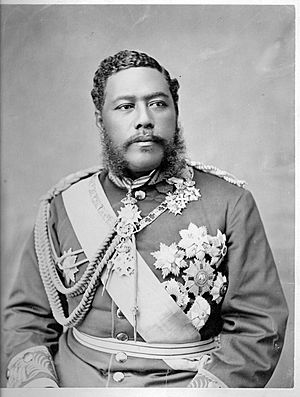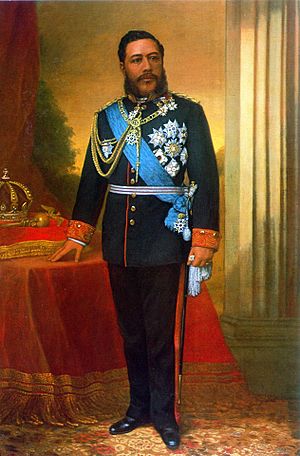Kalākaua facts for kids
Quick facts for kids Kalākaua |
|||||
|---|---|---|---|---|---|
| 'HM The King | |||||

Kalākaua I
|
|||||
| Reign | February 12, 1874 — January 30, 1891 (16 years, 342 days) |
||||
| Predecessor | Lunalilo | ||||
| Successor | Liliuokalani | ||||
| Born | November 16, 1836 Honolulu, Oahu |
||||
| Died | January 20, 1891 (aged 54) Palace Hotel, San Francisco |
||||
| Burial | Mauna Ala Royal Mausoleum | ||||
| Spouse | Queen Kapiolani | ||||
|
|||||
| House | House of Kalākaua | ||||
| Father | High Chief Caesar Kaluaiku Kapaʻakea | ||||
| Mother | High Chiefess Analea Keohokālole | ||||
Kalākaua I (born November 16, 1836 – died January 20, 1891) was the last king of Hawaii. His full name was David Laʻamea Kamanakapuʻu Mahinulani Nalaiaehuokalani Lumialani Kalākaua. People sometimes called him The Merrie Monarch because he loved joyful things. He ruled Hawaii from February 12, 1874, until he passed away on January 20, 1891.
Contents
Early Life of King Kalākaua
Kalākaua's parents were a high chief and a high chiefess. He had two older siblings and six younger siblings. When he was four, he started school. He learned to speak English and the Hawaiian language very well.
He began studying law at age 16. However, his government jobs kept him from finishing his legal training. By 1856, Kalākaua was a major on the staff of King Kamehameha IV. He also led a group called the Young Hawaiians. Kalākaua worked in the Department of the Interior. In 1863, he became the postmaster general.
Becoming King of Hawaii
The king before Kalākaua was King Lunalilo. He died on February 3, 1874. Kalākaua was chosen to become the next king. Kalākaua named his brother, William Pitt Leleiohoku, as the person who would take over after him.
Kalākaua started his time as king with a trip around the Hawaiian islands. This helped him become more popular with his people. In October 1874, he sent people to the United States to talk about a special agreement. In November, Kalākaua went to Washington DC to meet President Ulysses S. Grant.
They reached an agreement, and a treaty was signed on January 30, 1875. This treaty allowed certain Hawaiian goods, like sugar and rice, to enter the United States without extra taxes.
Challenges During His Reign
Early in his rule, King Kalākaua often fired his government advisors and hired new ones. This made some people unhappy. They wanted the Hawaiian government to be more like the United Kingdom's constitutional monarchy. They believed the lawmakers, not the king, should control the advisors. This disagreement continued throughout Kalākaua's time as king.
King Kalākaua's World Tour
In 1881, King Kalākaua left Hawaii for a trip around the world. He wanted to learn about immigration and make Hawaii's relationships with other countries better. He also wanted to see how other rulers governed their lands. While he was away, his sister and future queen, Princess Liliʻuokalani, ruled as a regent. (His first chosen heir, Prince Leleiohoku, had passed away in 1877.)
The King received a royal welcome in San Francisco. In Japan, he met with the Meiji Emperor. He continued his journey through China, Siam (now Thailand), Burma, India, Egypt, Italy, Belgium, the German Empire, Austria-Hungary, France, Spain, Portugal, and the United Kingdom of Great Britain and Ireland. He then returned through the United States.
During this trip, he met many other leaders, including Pope Leo XIII, Umberto I of Italy, Tewfik, Viceroy of Egypt, William II of Germany, Rama V of Siam, President Chester Arthur, and Queen Victoria of the United Kingdom. He became the first king in history to travel around the entire world.
Building and Culture

Kalākaua also built ʻIolani Palace. It cost $300,000, which was a huge amount of money back then. Many of the beautiful items inside the palace were ordered by Kalākaua when he was traveling in Europe.
Kalākaua decided to build the Kamehameha Statue. This statue honored Kamehameha I, who was the first king to unite all the Hawaiian Islands. The first statue was lost when the ship carrying it sank near the Falkland Islands. A new one was ordered and shown to the public by the king in 1883. The original statue was later fixed and sent to Hawaii in 1912. A third statue, put up in 1969, is in the United States Capitol. It is the only statue there that honors a native Hawaiian.
King Kalākaua was said to have wanted to create a large Polynesian Empire. In 1886, the lawmakers gave the government $30,000 to form a Polynesian confederation (a group of allied nations). The King sent people to Sāmoa. There, Malietoa Laupepa agreed to join Hawaii in a confederation. This group did not last long because King Kalākaua lost power the next year due to the Bayonet Constitution.
The Bayonet Constitution
By 1887, some people were very unhappy with Kalākaua. They blamed him for the Kingdom's growing debt. They said he spent too much money. Some foreigners wanted to force him to give up his throne and put his sister Liliʻuokalani in charge. Others wanted to end the monarchy completely and make the islands part of the United States.
The people who wanted to join the United States formed a group called the Hawaiian League. In 1887, members of this group, armed with guns, gathered together. The King was scared by this show of force. He offered to give his powers to the foreign ministers from the United States, the United Kingdom, or Portugal. Instead, the members of the league asked him to sign a new constitution.
This new constitution was called the Bayonet Constitution. It took away much of the King's power. It also took away the voting rights of most native Hawaiians. The lawmakers could now overrule a decision by the King. The King was no longer allowed to act without his advisors' approval. The House of Nobles, which used to be chosen by the King, would now be elected. Non-Hawaiian citizens could also vote. Robert Wilcox led a rebellion to give power back to the king, but it failed.
King Kalākaua's Final Days
By 1890, the King was sick. His doctor told him to go to San Francisco. His health continued to get worse. He died on January 20, 1891, at the Palace Hotel in San Francisco. His last words were, "Tell my people I tried."
Kalākaua's body was sent back to Honolulu on the American ship USS Charleston. Because he did not have any children, his sister, Liliʻuokalani, became queen.
King Kalākaua's Legacy
King Kalākaua was known as "the Merrie Monarch" because he loved the joyful things in life. While he was king, people started to perform hula again. (It had been banned by Queen Kaʻahumanu in 1830.) There is a hula festival named for him, the Merrie Monarch Festival. He also brought back the Hawaiian martial art of Lua, and surfing.
He and his brother and sisters were known as the "Royal Fours" because they were very talented musicians. He wrote "Hawaii Ponoi", which is the state song of Hawaii today. Kalākaua strongly supported the ukulele as a Hawaiian instrument.
"Kalākaua Avenue" in Waikiki is named after him. It is the main street of Waikiki. It goes from the Ala Wai Canal to Waikiki beach. It continues almost to the Diamond Head crater.
Images for kids
-
King Kalākaua, Scottish writer Robert Louis Stevenson, and "Kalākaua's Singing Boys", his own personal choir, c. 1889.
See Also
 In Spanish: Kalakaua para niños
In Spanish: Kalakaua para niños













